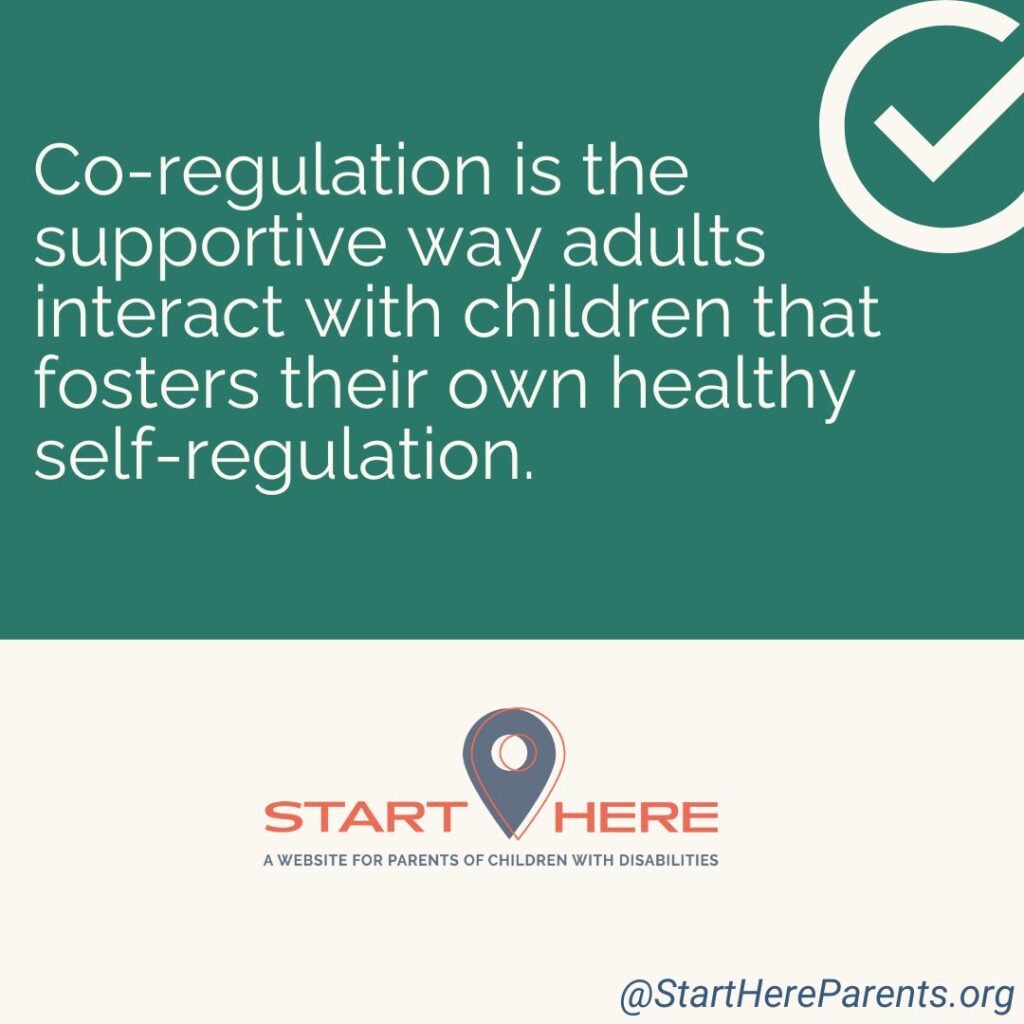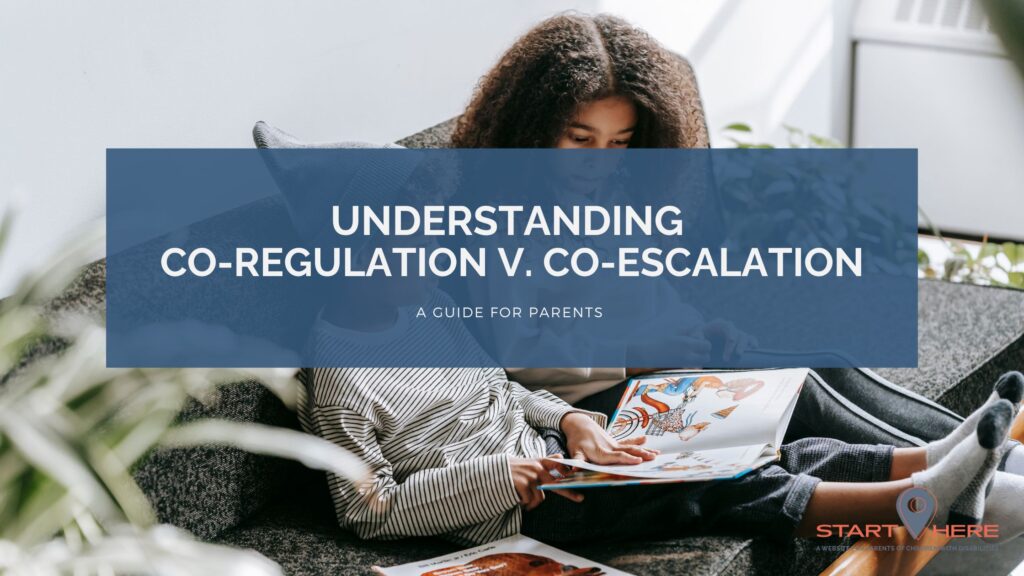
Navigating the emotional landscape of parenting a child with disabilities often requires a nuanced understanding of how interactions affect behavior and emotional states. Two critical concepts that can transform your interactions with your child are co-regulation and co-escalation. Understanding the way your reactions to a child’s behavior can increase the behavior or help calm them, ultimately changing the behavior, can help you to support your child’s emotional well-being and develop a more positive relationship.
So first, what do these two co- words even mean?
Co-Regulation is the process through which parents and children work together to manage and balance emotions. It involves the parent helping the child to calm down, stabilize their mood, and develop self-regulation skills. This is especially important for children with disabilities who may have challenges in managing their emotions independently. It’s important to note that young children often have limited to no ability to self regulate on their own and look to their parents to develop this skill.
What is Co-Escalation, on the other hand, occurs when interactions between the parent and child contribute to a worsening of the child’s emotional state. This can happen when both parties become overwhelmed, frustrated, or anxious, leading to increased tension and potentially exacerbating the child’s behavior or distress.
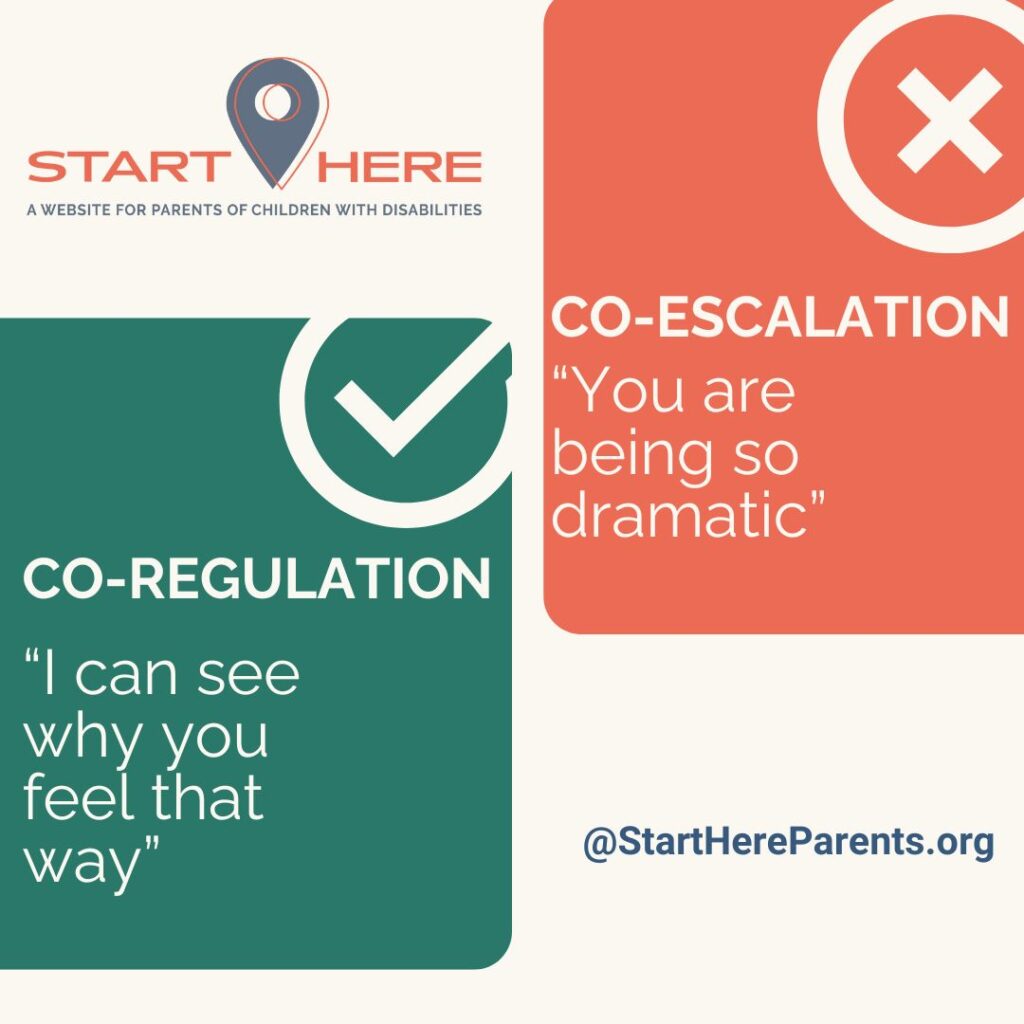
Ways to Co-Regulate With Your Child:
- Emotional Presence: Your calm and steady demeanor helps your child feel secure and can positively influence their emotional state. This involves being present, attentive, and empathetic. Children can feel if you are not actively listening and will escalate behavior as a way of attention seeking.
- Modeling Behavior: Children often learn how to handle emotions by observing their parents. Demonstrating healthy emotional regulation and problem-solving strategies can be incredibly beneficial. Taking the time to co-regulate with your children at a young age will help them learn how to self-regulate as they grow.
- Verbal and Non-Verbal Cues: Use soothing words, a calm tone of voice, and comforting physical touch (like holding hands or a gentle hug) to help your child navigate their emotions while knowing that you are there for them.
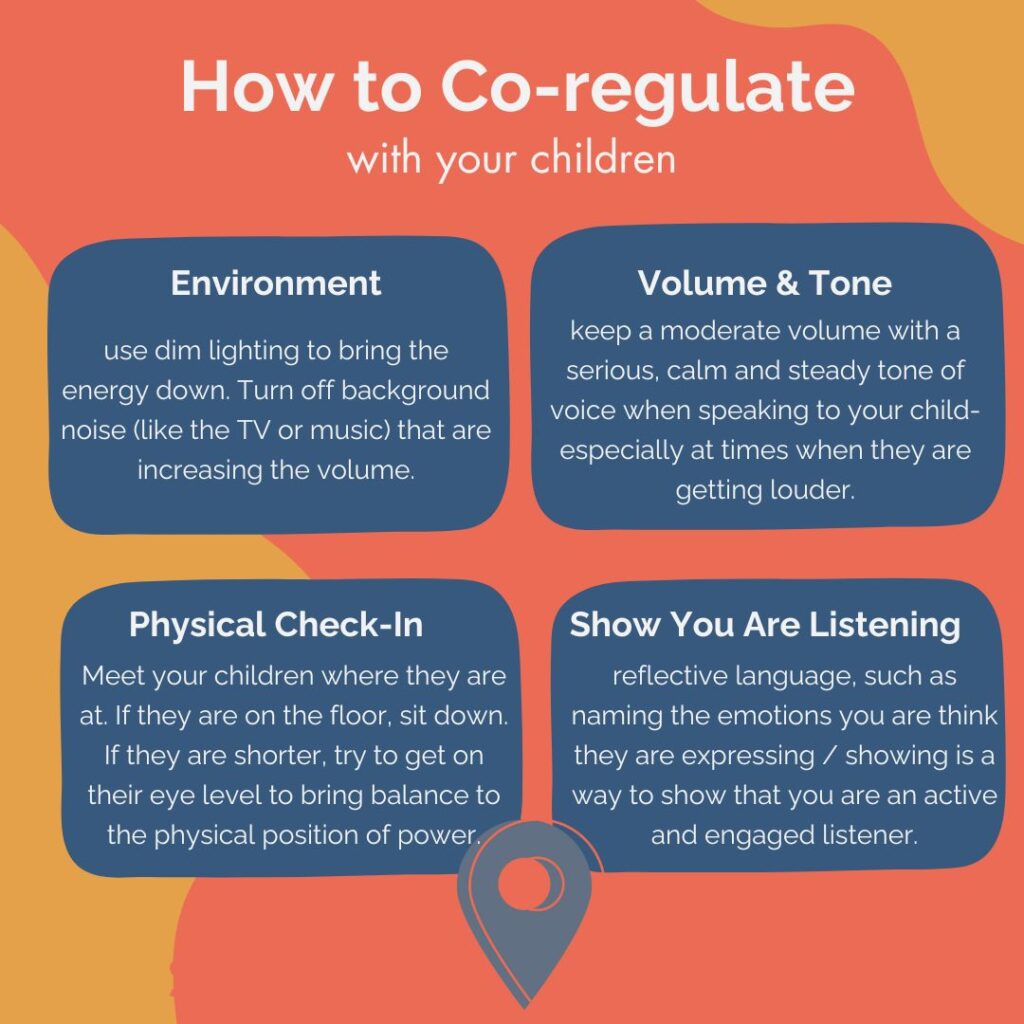
Examples of Co-Regulation:
- During a Meltdown: If your child is experiencing a tantrum or meltdown, remain calm and use a soothing voice to offer reassurance. For example, “I know you’re upset, but we’re going to get through this together. Let’s take some deep breaths. I am here for you and it is going to be ok.”
- Routine and Structure: Implement consistent routines that provide a sense of security. For instance, having a predictable bedtime routine can help your child feel more in control and less anxious.
- Emotional Coaching: Help your child identify and name their emotions. If they are frustrated, you might say, “It looks like you’re feeling frustrated because the puzzle is hard. Let’s take a break and try again.”
Actions That Can Lead to Co-Escalation With a Child:
- ‘Emotional Contagion’: Emotions can be contagious. If a parent becomes anxious or angry, it can heighten the child’s stress and escalate the situation. Remember, little humans are still learning everything about the world. They look to you as their baseline for how to react in certain situations, especially ones that are confusing or stressful.
- Escalating Responses: Responding to your child’s outbursts with anger or frustration can intensify their emotional state. This might include raising your voice, showing visible irritation, or reacting impulsively. Any physical or emotional reaction meant to force a new behavior in a child instills fear, feelings of being scared make any kind of emotional regulation much more difficult.
- Lack of Boundaries: Failing to establish clear boundaries and expectations can lead to confusion and increased emotional instability for your child.
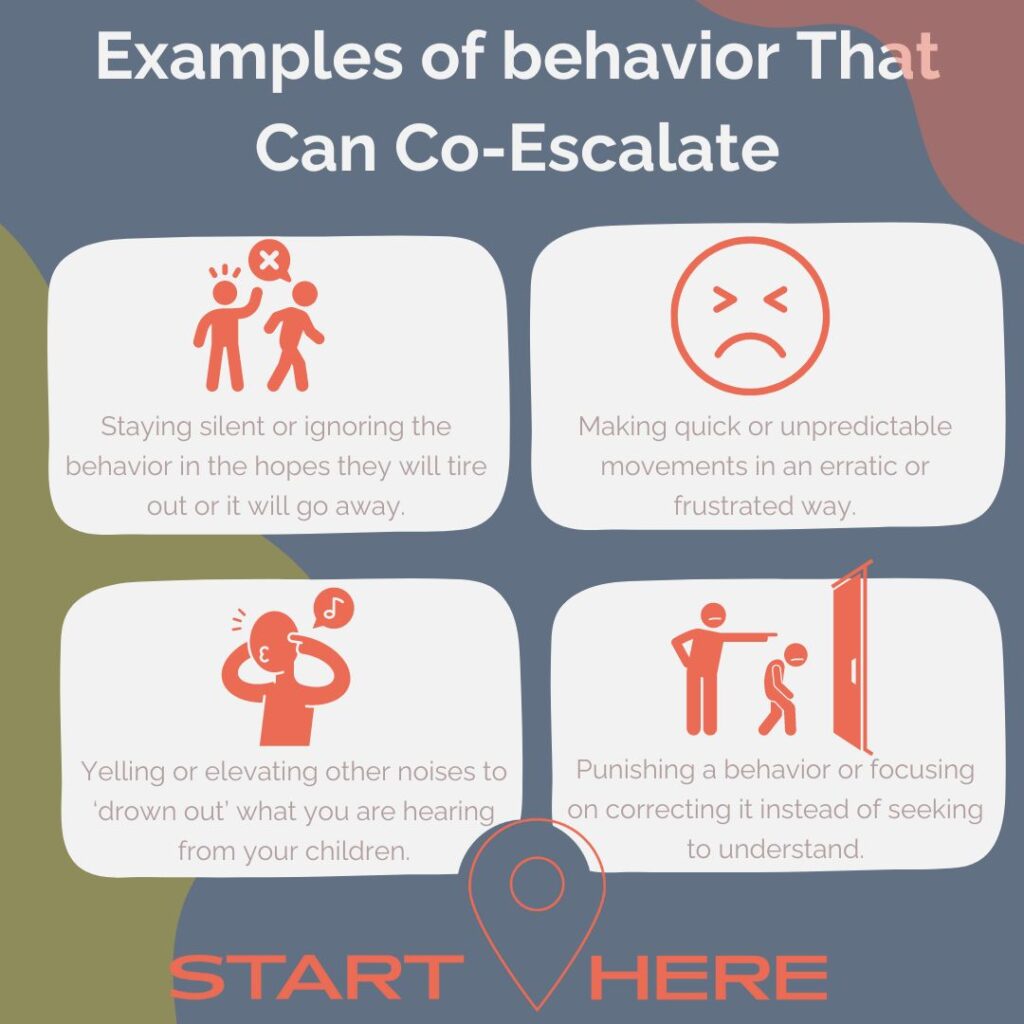
Examples of Co-Escalation:
- Power Struggles: If your child is resisting a transition and you respond with frustration or demands, the conflict can escalate. For instance, saying, “I told you to stop, and you’re not listening!” can lead to further defiance and distress.
- Inconsistent Responses: Providing mixed signals or inconsistent responses to your child’s behavior can cause confusion and heighten emotional reactions. For example, if you initially ignore a behavior and then react strongly later, it can escalate the situation.
- Overreacting: Reacting strongly to minor issues or becoming overwhelmed by your child’s behavior can worsen their distress. For example, if your child spills something and you respond with anger, it can make them more upset and anxious.
Strategies for Effective Co-Regulation and Avoiding Co-Escalation
- Practice Mindfulness: Stay aware of your own emotional state. Mindfulness techniques can help you remain calm and composed during challenging moments. If you are feeling tense try to find time and ways to incorporate self care before engaging with others. Remember the saying ‘you can’t fill someone else’s cup if yours is empty’.
- Develop Coping Strategies: Equip yourself with strategies to manage your emotions, such as deep breathing, taking a short break, or using calming techniques like visualization. There are all kinds of apps and other supports that exist. For some people, it’s taking a walk, for other’s it’s a cold shower – keep trying things until you find what management strategies work best for you.
- Create a Calm Environment: Design a calm and organized space where your child can retreat when they feel overwhelmed. This can help both of you regain composure during high-stress moments. Ideally this is a location with calming light, sounds and other grounding resources available.
- Seek Support: Don’t hesitate to seek support from professionals such as therapists or counselors who can offer additional strategies and guidance tailored to your family’s needs. Parents, you don’t have to do it all. Leaning on professional help can provide the support needed to navigate what is a really tough job- parenting!
- Reflect and Adjust: After a challenging interaction, reflect on what worked well and what didn’t. Adjust your approach based on these reflections to improve future interactions. Don’t be afraid to acknowledge or apologize if it feels warranted. You can tell your child the ways you wish you had reacted differently after the fact, it’s a good way to demonstrate apologies, repair and open communication.
Conclusion
Understanding the dynamics of co-regulation and co-escalation can significantly impact your parenting approach. By striving for co-regulation, you foster a supportive environment that helps your child develop emotional resilience. Conversely, being aware of the accidental ways we can co-escalate allows you to proactively manage and mitigate emotional conflicts.
Remember, parenting is a journey, and learning how to effectively co-regulate while avoiding co-escalation can lead to more positive interactions and a deeper connection with your child. Like most things, co-regulation is about providing consistent, loving support while maintaining warm and important boundaries. No human can get it right all the time, but small changes add up to big results over time.
